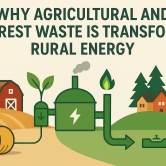Ever since humanity harnessed the power of fire, it has depended upon it to cook, stay warm, and provide energy for other uses. Through many parts of the third world, the traditional practice of burning biomass and waste to produce heat and other forms of energy continues to help meet the need of such arising from a lack of reliable modern energy services. Though lower income regions are beginning to use more modern forms of energy, biomass and waste still remain a common source of energy, and account for 14 % of worldwide energy output.
Areas Where Biomass and Waste are Used as a Primary Source of Energy
Wood, forestry residue, animal dung, human excrement, and agricultural residues in the form of crop waste like stalks and coconut husks are used. Though these are renewable energy sources, the stoves used for burning these fuels are the inefficient “three stone stoves.” These stoves have an energy efficiency of only 10 %, so 90 % of the biomass burnt is wasted.
Most of the biomass is used as the primary energy source by people for heating and cooking, ranging from 65 % in Haiti, 72 % in Kenya, 78 % in the Democratic Republic of Congo, 81.5 % in Nigeria, 85 % in Tanzania, to 89 % in Kenya and Niger. In all the countries, rural households are more dependent on biomass than peri-urban and urban areas for cooking. Its use in rural households varies in different countries, from 99 % of the population in Ethiopia, to 95 % in Mozambique.
While in urban Ethiopia biomass is used by 84 % of the population. In addition, 12 % and 6 % of the biomass is used for transportation in Haiti and Nepal, respectively. Industrial use of biomass for heating is prevalent in Haiti (4 %), Nepal (6 %), Myanmar (20 %), and Sudan (20 %). These are usually small scale industries like sugar mills, sawmills, brick production, and tobacco curing. Other users of biomass are commercial services like restaurants and baking, as well as arts and crafts. Nepal also uses 1 % of its wood in agriculture.
Regions Dependent on Traditional Biomass for Fuel
Traditional biomass use as fuel is strongest in Africa, where the extraction of wood from forests and savannas is more for fuel than for timber. 15 out of the 20 countries listed as heavy users of biomass are in Africa. Two Central American countries, Haiti (81 %) and Guatemala (62.8 %), and three Asian countries, Nepal (80.6 %), Cambodia (66.9 %) and Myanmar (65.3 %), also depend heavily on biomass.
Countries Turning Waste And Biomass Into Energy
| Rank | Country | Biomass and Combustible Waste as Percentage of Energy Supply |
|---|---|---|
| 1 | Ethiopia | 92.9 % |
| 2 | Democratic Republic of Congo | 92.2 % |
| 3 | Tanzania | 85.0 % |
| 4 | Nigeria | 81.5 % |
| 5 | Haiti | 81.0 % |
| 6 | Nepal | 80.6 % |
| 7 | Togo | 79.9 % |
| 8 | Mozambique | 79.8 % |
| 9 | Eritrea | 78.2 % |
| 10 | Zambia | 76.9 % |
| 11 | Ivory Coast | 73.6 % |
| 12 | Niger | 73.2 % |
| 13 | Kenya | 72.2 % |
| 14 | Cambodia | 66.9 % |
| 15 | Myanmar | 65.3 % |
| 16 | Cameroon | 65.0 % |
| 17 | Sudan | 62.9 % |
| 18 | Guatemala | 62.8 % |
| 19 | Zimbabwe | 61.8 % |
| 20 | Republic of Congo | 59.2 % |
REFERENCE: https://www.worldatlas.com/articles/20-countries-burning-the-most-waste-and-biomass-for-energy.html




